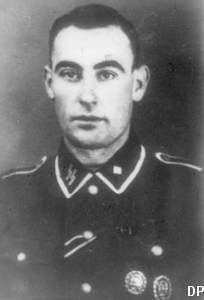Allegiance Nazi Germany Years of service 1938–45 Other work Sports reporter Died July 12, 2007, Uberlingen Rank Obersturmfuhrer | Service/branch Luftwaffe Waffen SS Battles/wars World War II Name Paul Egger Battles and wars World War II | |
 | ||
Born 26 November 1916Mautern, Austria ( 1916-11-26 ) Awards Knight's Cross of the Iron CrossGerman Cross in GoldIron Cross I ClassIron Cross II ClassInfantry Assault Badge in SilverWound Badge in Gold Combined Pilots-Observation BadgeFront Flying Clasp of the Luftwaffe in Gold Unit Luftwaffe, Kampfgeschwader 51, Jagdgeschwader 27, Waffen-SS, 102nd SS Heavy Panzer Battalion | ||
Paul Egger (26 November 1916 – 12 July 2007) was a German pilot in the Battle of Britain and an Obersturmfuhrer (first lieutenant) in the Waffen-SS during World War II who was awarded the Knight's Cross of the Iron Cross, which was awarded by Nazi Germany to recognize extreme battlefield bravery or successful military leadership during World War II.
Contents
Early life
Paul Egger was born on 26 November 1916 in Mautern, Austria. After graduating from high school in June 1935, he trained to be a clerk and worked as a trainee clerk until 1938, when he volunteered to join the Luftwaffe. Egger was already a Glider pilot and was converted to be a bomber pilot and posted to the Kampfgeschwader 51 flying the Junkers Ju 87 (Stuka).
World War II
Egger started World War II as a pilot in Kampfgeschwader 51 and took part in the Polish Campaign. He was then transferred to Jagdgeschwader 27 as a fighter pilot flying the Messerschmitt Bf 109 and took part in the Battle of France, and the Battle of Britain. Altogether he flew 112 missions and was shot down three times; he did record some victories but was not a fighter ace. The last time he was shot down over the English Channel he received severe head wounds and was removed from flying and transferred to ground staff duties.
Waffen SS
In May 1941 he volunteered to join the Waffen-SS, and was trained as an anti-tank gunner. On completion of his basic training he was posted to the Motorcycle Battalion of the Das Reich Division and later transferred to the 8th Company, SS Panzer Regiment 2. Egger started to show his prowess as a tank commander in the Battle of Kiev when he destroyed 28 tanks, 14 anti-tank guns, 40 other vehicles and 8 artillery batteries.
During the Third Battle of Kharkov in February 1943, he recorded his 65th tank destroyed but his company was almost wiped out and by the end of the battle had only two tanks left.
In October 1943, Egger was transferred to command a Tiger tank platoon in the 1st Company, 102 SS Heavy Panzer Battalion. The battalion was sent to Normandy after the D Day landings. During the fighting for point 112 he destroyed a further 14 tanks and 4 anti tank guns for which he was recommended for the Knight's Cross but instead received the German Cross in Gold.
Egger's battalion was almost completely destroyed during the fighting in Normandy. In September 1944 it was pulled back to Germany to reform. Stationed in Sennelager the battalion was renamed the 502 SS Heavy Panzer Battalion.
The battalion was sent to the Eastern Front and during the fighting around Stettin he destroyed another 19 tanks. In April 1945 he was directly promoted to Obersturmfuhrer (first lieutenant) and temporarily took over command of the 1st Company. He was awarded the Knight's Cross by the commander of the XI SS Panzer Army Felix Steiner (due to the circumstances at the end of the war, the award was only provisionally granted). The certificate was endorsed by Heinrich Himmler and Generalfeldmarschall Wilhelm Keitel and dated 28 April 1945, but it is recognized by the Ordensgemeinschaft der Ritterkreuztrager des Eisernen Kreuzes e.V. (OdR).
On the 3 May 1945, Egger recorded 113 tanks destroyed.
He escaped from Berlin and managed to evade the surrounding Soviet forces, but was forced to surrender to the advancing United States army at the River Elbe after being shot in the arm, which was his ninth wound of the war.
Post war
Paul Egger remained in captivity for two and a half years and was released in November 1947.
In civilian life he became a sports reporter and died on 12 July 2007.
